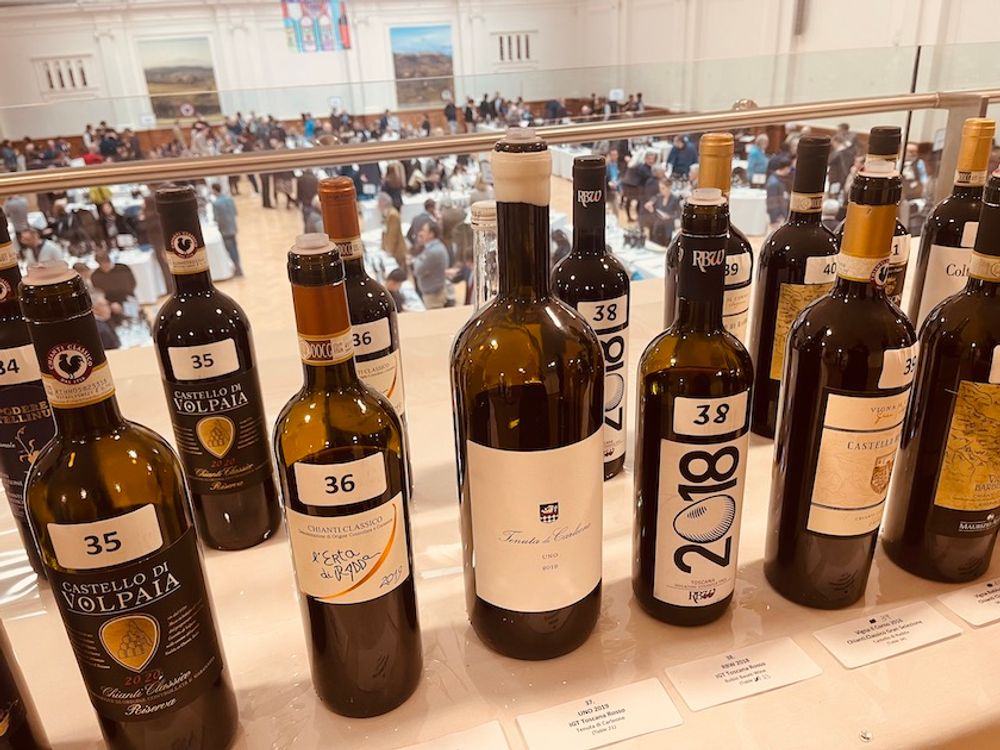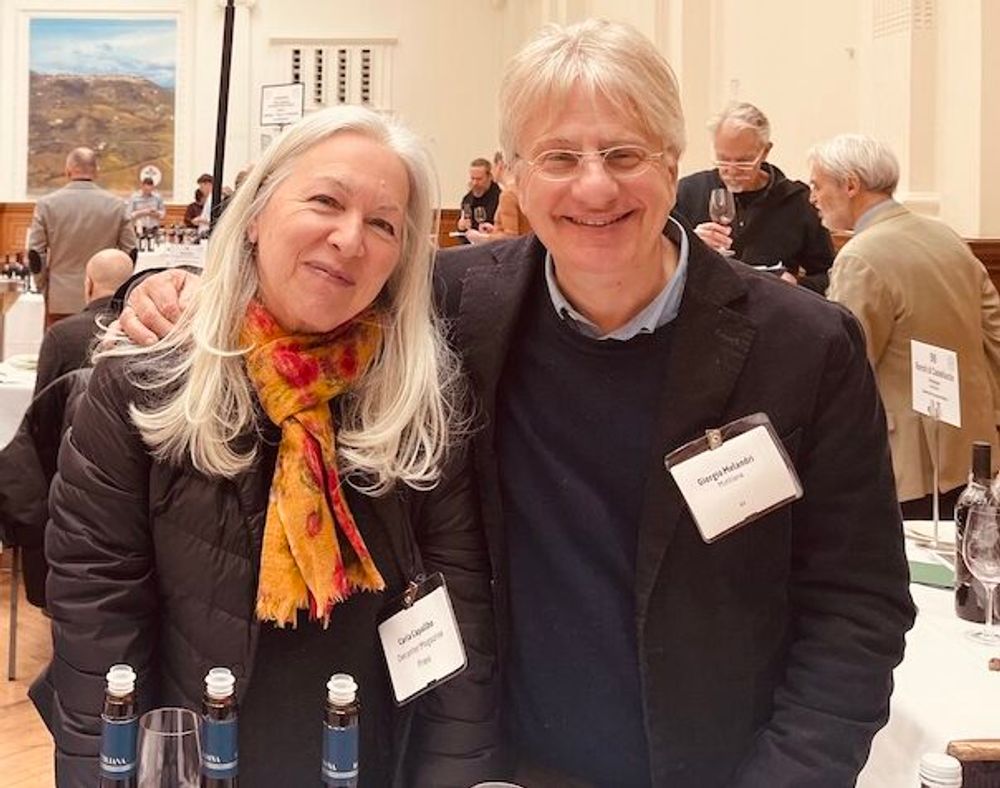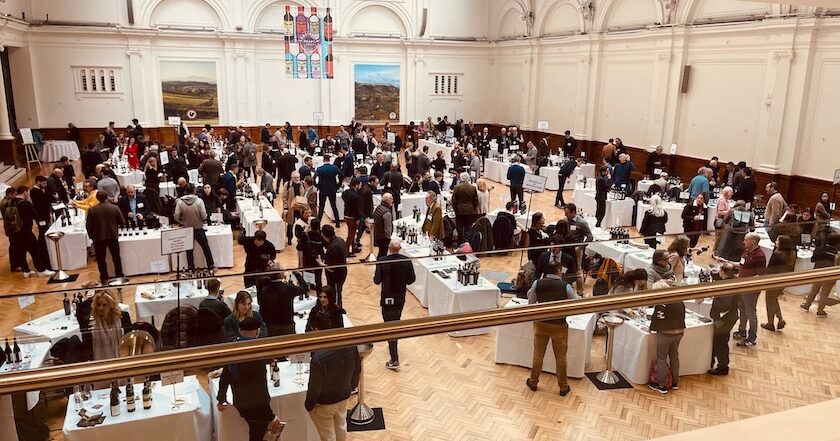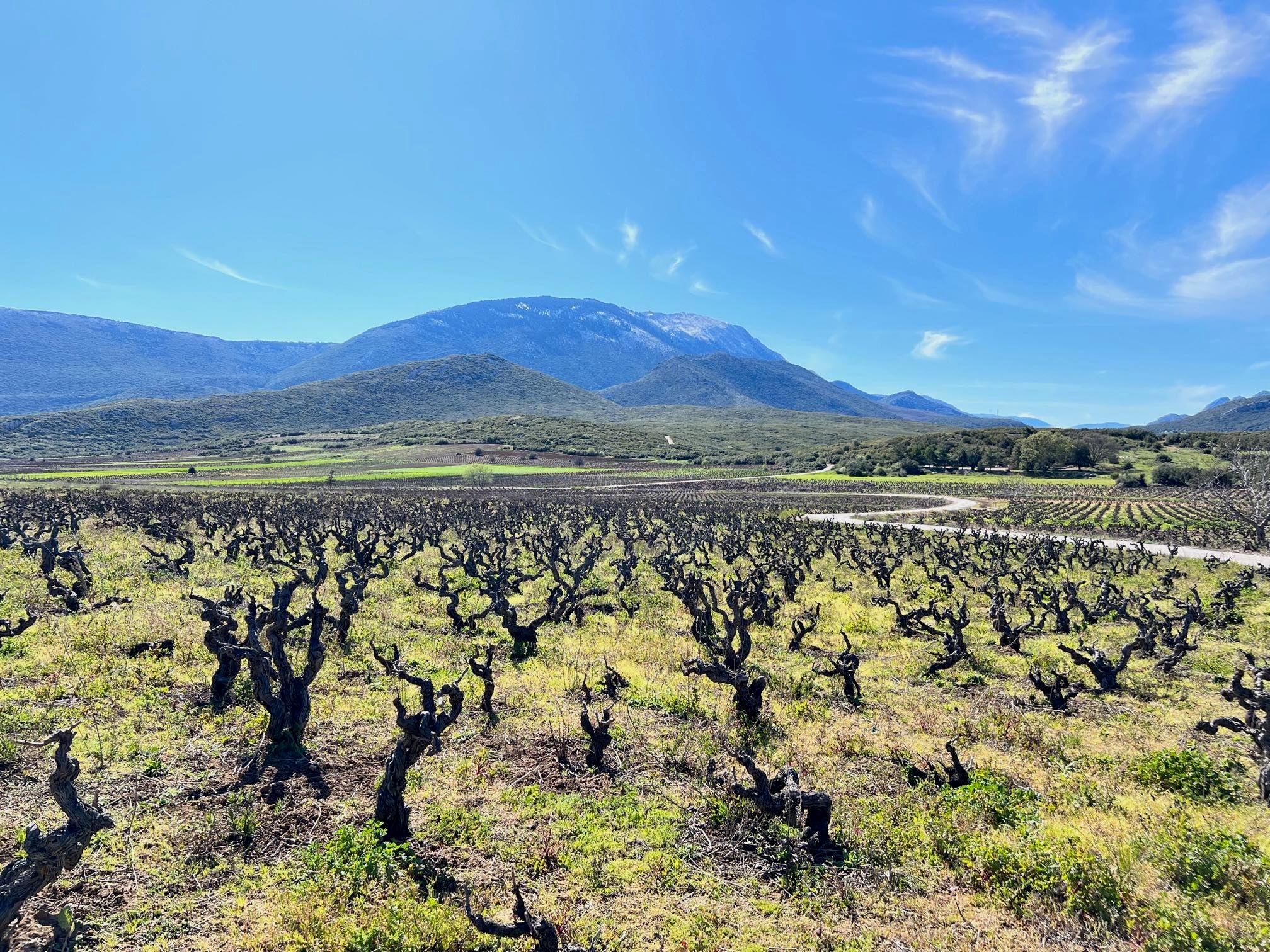Wines on show at Sangiovese Reset hailed from Tuscany, Emilia-Romagna, Umbria, Le Marche and even Basilicata, while Speller teamed up with renowned Italian writer Georgio Melandri to showcase aged classics.

Sangiovese Reset: March 7, 2023, London
Jane Hunt MW and Walter Speller have got form when it comes to Sangiovese. Troubled by its misrepresentation in the UK market, they established ‘Sangiovese Reset‘ without involving the region’s consorzi, ensuring they were stringent about the producers they invited. Their aim? To address the generic marketing of rather ordinary Italian wine being made by larger producers.
Sangiovese zealots, Hunt and Speller see ‘the blood of Jupiter’ (‘sanguis Jovis’ in Latin) as one of the world’s greatest red varieties – no workhorse grape but, rather, a hypersensitive transmitter of terroir that requires delicate handling.
Sangiovese and I also have some form. As an 18-year-old, I arrived in its Tuscan heartland to work in a rural hamlet near Tavarnelle Val Di Pesa, staying for several months. Italy was in the throes of one of the greatest political and financial crises in its short history. A judicial investigation into political corruption at one point implicated more than half the Italian parliament; widespread proof of kickbacks or bribes paid for government contracts led to politicians being indicted in droves; some even committed suicide. This snowballed, leading to the collapse of the traditional parties in Italy and a new majority voting system. Elsewhere in Europe, the Berlin Wall had fallen and communism had imploded.
Sangiovese was also undergoing a reckoning of its own. As the world’s biggest wine producer, volume trumped quality in Italy. In 1992, a law was passed to restructure the entire classification system. At this time, Chianti, made mostly from Sangiovese, was in every British bistro, off licence or corner shop. Distinctively marketed in a raffia-clad flask (called a ‘fiasco’), the bottles enjoyed a resilient secondary market as lamp stands in many a student dig.
Lax wine laws meant that Trebbiano and Malvasia accounted for 10 percent of the Chianti blend, high acid and diluted flavours resulted, as did illegal doctoring with generic Sicilian red wine. Yet where I lived, in the depths of Tuscany, you could find the most deliciously zippy, cranberry, cherry-noted, herb-tinged, floral Sangiovese for pennies. Provided you remembered to bring along a container to transport it.
Sangiovese undergoes a clonal reset

“For a time, the finger of blame for poor quality wines was pointed at the variety, rather than the clone or farming methods.”
Italy grows around 65-thousand hectares of Sangiovese, easily its most planted variety. It is widespread in central Italy, both on the Tyrrhenian and Adriatic coasts, but you may also find it in Campania, Sicily, Veneto and Lombardy. Aside from Chianti, it forms the main component of Vino Nobile di Montepulciano, Morellino di Scansano and is the sole grape of Brunello di Montalcino.
This widespread planting suggests that the grape is easy to grow, but the reality is the opposite. Although Sangiovese is a vigorous variety, producing prodigious quantities if not kept in check, it requires the best sites on the poorest soils, low yields, delicate handling, low intervention winemaking and little or no oak to reveal its true character.
Unfortunately, highly productive clones such as R10 found fashion in the 1970s. As a result of post-war privations and a desperate need for financial recovery, widespread cultivation was encouraged by the government. R10, says Speller, can deliver enormous yields with large bunches, resulting in insipid, tart wines with unripe tannins and limited structure.
For a time, the finger of blame for poor quality wines was pointed at the variety, rather than the clone or farming methods. The general consensus on Sangiovese, even within Italy, was that improvement could only come from blending with other grapes. Cue the Super Tuscans: a new epoch of structured blends that signalled a move away from strict regulation towards the addition of unsanctioned Bordeaux varieties.
Antinori’s 1971 Tignanello was the first Super Tuscan, incorporating fifteen percent Cabernet Sauvignon and five percent Cabernet Franc; Sassicaia, Ornellaia and Masseto are famed examples too. Deep, powerful wines, aged in French oak rather than the traditional Slovenian, they hit the American zeitgeist and sold well. However, critics caution that they are not in the least bit representative of Sangiovese, which was historically blended with indigenous grapes such as Canaiolo.
“When Italian law allowed the inclusion of French varieties in almost every denomination, while describing them as ‘ameliorating’, it was a disastrous move which signalled to the international market that Italy’s own indigenous varieties were simply not good enough,” says Speller.
From 1996 the use of white grapes was outlawed in Chianti Classico and over the last couple of decades, change has been widespread. The Consorzio Chianti Classico has endorsed quality improvements, including exhaustive research into suitable clones for specific sites, information it now provides to producers without charge.
Champions for Sangiovese in Modigliana

Giorgio Melandri pictured with author and friend, Carla Capalbo
Today, Sangiovese is experiencing a renaissance, championed by writer Giorgio Melandri, whose influential tasting notes and exceptional knowledge, amassed over twenty years, finally turned him batty enough to produce wine himself. Giorgio worked for Gambero Rosso, Italy’s celebrated wine and food bible. Each year, as he supped his way through gallons of Italian vino, he could not help but notice that Sangiovese had an uncanny knack for expressing terroir.
Melandri is a native of Modigliana in Romagna, a small municipality in the Apennine mountain range, dividing Emilia Romagna and Tuscany, which sits on the ancient salt route from Faenza to Firenze. Though Sangiovese’s origins are disputed, he believes the variety likely hails from the Apennines, rather than Tuscany.
The flavour profile of Sangiovese typically includes sour cherry, violet, pomegranate, tomato and earthy notes, though in the past much of it has been stifled by barrique ageing. It is, says Melandri, an elegant, juicy, vibrant variety capable of greatness. Delicately fruity, his Sangiovese has a dry floral character. He produces three single vineyard wines on three completely different soils for his label Mutiliana, one of eleven local producers who have formed a Romagna collective heavily influenced by the French natural wine movement. They are, he says, ignoring the more modern methods of their fathers and instead returning to the wisdom of their grandfathers.
Named after the three valleys of Modigliana – Ibola, Tramazzo and Acerreta – each of Melandri’s wines expresses the terroir of its roots. Ibola sits on sandstone and is typically elegant and austere. Tramazzo on marl, sandstone and clay and shows finesse and energy. Finally Acerreta, grown on a combination of marl and sandstone, is delicately fruity with a tight tannic structure.
Francisco Bordini, from neighbouring Villa Papiano, vinifies many of the wines for growers in the Modigliana collective, including Melandri’s Mutiliana. He says the altitude, forest and sandstone distinguish the wines of Modigliana from their Tuscan counterparts. He advocates waiting four or five years before drinking, but says they will keep for at least twenty. He loves to use concrete and little else, though his Reserva sees 3000 litre Slavonian botti.
“Sangiovese from this region has minerality, high acidity and freshness. And we like to produce naked wine with absolutely nothing added. Dried rose, pomegranate and red orange all feature in the taste profile of our Sangiovese,” Bordini says.
“Modigliana has three clearly different styles according to the valley from which the grapes come, all are at higher altitude than Tuscany and therefore cooler. Ibbola is more extreme, more fruity, more fresh. Tramazo is from a cool windy valley and the wines tend toward spice and crushed herbs. Acereta comes from a warmer valley and you sometimes find herbs and red orange as well as more tannins.”
Understanding the way Sangiovese has been re-assessed
Brunello de Montalcino is 100 percent Sangiovese by law, yet in 2008 a scandal erupted when significant quantities of the wine were found to include illegal varieties. Interestingly, at the time many reputable brands apparently lobbied for a change in the law to accommodate this failing, the suggestion being that blending Sangiovese was a necessary evil.
Today, says Speller, there has been a remarkable change in attitude and also in the look of Brunello di Montalcino (Brunello being the local name for Sangiovese). It is lighter, more diverse and original, just as it should be.
Often austere, age-worthy Sangiovese is not a simple wine – you must wait to be seduced and make the effort to comprehend – yet reduced oak, lower yields, modern trellising, careful clone choice and gentle vinification are increasingly delivering Sangiovese with a sense of place.
The variety produces some of the most sensual, sublime and intellectually stimulating wines on the planet, made beguiling with the onset of age. As complex, layered and unstable as Italy itself, Sangiovese can be challenging and harsh, but if you grow it in the right place and vinify it with delicacy, you might just touch grace.
Tasting the wines at Sangiovese Reset

The ancient Greeks christened Italy ‘Oenotria’, and the name remains well placed. Italy’s mountainous backbone, her incredible soil diversity, temperate climate and unique smorgasbord of indigenous grapes all work in her favour. Add to that a healthy disrespect for central government and you have ideal ground for diverse grape bottlings and localised terroir expression.
Wines on show at Sangiovese Reset hailed from Tuscany, Emilia-Romagna, Umbria, Le Marche and even Basilicata. Wild cards and traditionalists attended. A selection of notes from the walk-around tasting plus Speller and Melandri’s Romagna Sangiovese Historical Masterclass, follow:
Fattoria Zerbina, Pietramora 1985, Sangiovese di Romagna DOC Superiore Reserva
Aged in Estonian large format casks. Terracotta colour, shows a distinctive and delicious aged integrated profile of rich, dark, bitter coffee, walnuts, chestnuts, the flavour of molasses without the sweetness, iodine, plum, tea, smoky wet bonfires, a bat squeak of cigar smoke and bitter walnut skin. Has a velvety silken texture and the finish is delicious; dry and grainy with ripe tannins. Sublimely complex, an endless vinous tome in a delicate vessel. Delicious.
Ronchi di Castelluccio, Ronco Casone 1986, Vino da tavola di Modigliana
Fresh and mouth-wateringly moreish with notes of smooth caramel, black chocolate, burnt sugar, balsamic and creamy vanilla custard. There is an element of spice, of nutmeg and smooth, silky, lithe-textured tannins. Complex and intriguing, velvety and smooth, a mentally stimulating mind massage.
Il Pratello, Badia Raustignolo 2001, Forlì IGT (Modigliana)
This wine is made from grapes planted above 500m. 50-day skin maceration, aged in barriques for 36 months. Crème Brûlée, vanilla and bitter burnt sugar, toffee, dark coffee-soaked walnuts, black tea, salty sour plum and smooth, milky chocolate and the texture of velvet. I can see the light.
Nicolucci, Vigna del Generale 2010, Romagna DOC Superiore Reserva Predeppio Alta
Intense aromatics, silky chalky tannins and delicious sapid sour cherry notes. Gamey animal, rich dark black cherry, morello and chocolate nibs; Smooth, dark, fresh, earthy and delicious. This wine comes from the oldest vineyards in Romagna (90 years) and is clearly capable of long ageing. There is something super sensual and distinctly naughty about this wine.
Mutiliana, Acereta 2015, Modigliana DOC
Concrete only, no wood. Dark chocolate nibs, spiced ripe black cherry, Wiśnówka, earth, wet woodsmoke and dark, savoury intense herbal notes of sage, black tea, thyme, dried rose, blood orange and rosemary. The tannins are structured and delicious, a really fascinating wine that will continue to morph and move, I am convinced of future greatness.
Gallegati, Corallo Nero 2019, Brisighella Romagna DOC
Sour Morello cherry, salty violet, iodine and red pomegranate, cranberry and cherry. Smoothly textured and sapid with delicious bitey tannins.
Mutiliana Tramazo 2019 Romagna Sangiovese Modigliana DOC
Terracotta coloured. Sour, silky and sapid with ripe cherry, black tea, blood orange and pomegranate tempered by savoury thyme, salt and sage. Dry chewy tannins. Long and fresh; grippy and thought provoking. I will return, this will surely age beguilingly.
Noelia Ricci, II Sangiovese 2021 Romagna Sangiovese Predappio
Sensual cigar smoke and supple dark ripe cherry, paprika, earth, blood and spice.
Querciabella 2019 Chianti Classico
Black cherry, dried crushed rose petals, thyme, sweet juicy raspberry and cherry, dry chalky savoury tannins and stony mineral notes too. Long and luscious.
Tenuta di Carleone, UNO 2019 IGT Rosso (in magnum)
Gorgeously fragrant florals and sweet spices, crushed herbs, iodine, dried rose petals, sage, cherry, plum and thyme. Sapid, fresh, light, layered and oh so sublimely silky.
Robin Baum Wine RBW 2018 IGT Toscana Rosso
Sapid, succulent, fresh and cherry red, dry chalky moreish tannins dusted with cherry sherbet.
San Donatino, Halley 2019 Vino Rosso biologico di Castellina in Chianti
Super sweet on the nose, strawberry, plum, pomegranate, it is smoky and sapid and reminds me of those lovely farm wines I supped in my youth. Eminently gluggable.
Sangiovese Modigliana, Papesse 2021, Villa Papiano
Pure and crunchy with notes of pomegranate, sour cherry, iron, blood, saline and thyme, young and fresh, vibrant, juicy and promising.
Sangiovese Modigliana, Vigna Probi 2018, Villa Papiano
Pronounced acidity and full tannins, its excellent ageing potential is clear and it does have a note of sour cherry, blood orange, saline, iron, dried rose petals and pomegranate. It is earthy too.










































